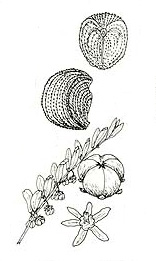Family: Phyllanthaceae
Phyllanthus lacunarius
Citation:
F. Muell., J. Trans. Vict. Inst. 1:14 (1854).
Synonymy: Not Applicable Common name: Lagoon spurge, Caraweena clover.
Description:
Small diffuse much-branched often very glaucous annual or perennial herbs; branches flattened or angular, somewhat wiry, 2-25 cm long, often woody at the base and arising from a central rootstock; leaves alternate, very shortly petiolate, oblanceolate to cuneate, rarely oblong, 7-12 x 1-7 mm, flattish, mid-nerve fine, ending in a small mucro; stipules linear-lanceolate, c. 1.5 mm long, with white scarious margins, caducous; monoecious.
flowers white or reddish, axillary, with 6 lanceolate perianth-segments, 2 or 3 males and 1 female, on very short peduncles; male flowers with reddish perianth-segments to 1 mm long with wide white scarious margins; filaments and anthers free, anthers dehiscing lengthwise; glands small; female perianth-segments greenish, in fruit to c. 2.5 mm long, with narrow white hyaline margins, stellately spreading in fruit, and on a 2-3 mm long peduncle, remaining on the stem after dehiscence of the capsule; glands finally forming a basal plate; style short, deeply 2-fid, segments spreading.
Capsule depressed-globular, c. 3 mm diam., 3-lobed, smooth, glaucous, longer than the segments, hanging from the lower side of the branches in regular rows; seed brown, 1.2-1.5 mm long, striate, with dark-brown solid ridges lengthwise.

| Phyllanthus lacunarius twig, fruit, calyx of fruit has been shed and 2 cocci.
|
Image source: fig 406e in Jessop J.P. & Toelken H.R. (Ed.) 1986. Flora of South Australia (4th edn).
|
Published illustration:
Jessop (1981) Flora of central Australia, fig. 218; Cunningham et al. (1982) Plants of western New South Wales, p. 460.
|
|
Distribution:
|
all mainland States.
|
Conservation status:
native
Flowering time: all year around.
|

SA Distribution Map based
on current data relating to
specimens held in the
State Herbarium of South Australia
|
Biology:
Found on most soil types, in creek beds. Is suspected of poisoning stock (Everist (1977) Poisonous plants of Australia, p. 282).
Taxonomic notes:
Black regarded this species as an annual and most specimens appear to be annual with greenish stems. Some collections include rather variable specimens with stems ranging from 2 to 10 cm long. Stems arise from a small zig-zag tap root which is brown and appears woody, while bigger specimens with longer branches become brown and woody at the base. It is impossible to determine on such specimens the age of the plants, but the small ones could be annual and the larger specimens biennial or perhaps perennial. Some collections consist only of old specimens, on which the basal portion of the branches are distinctly woody, but ultimate branches are green and indistinguishable from the small annual plants. I believe P. lacunarius is a perennial plant.
Author:
Not yet available
|

